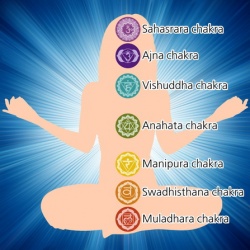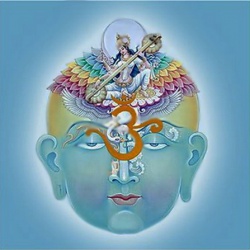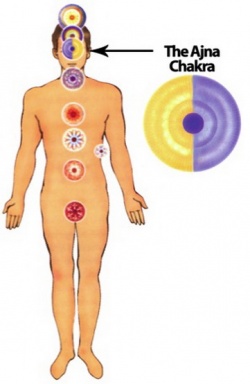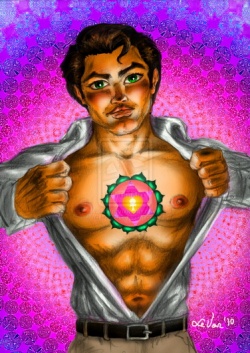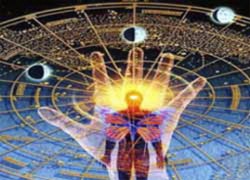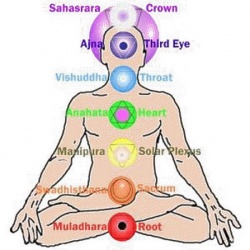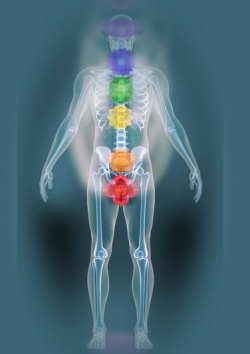Kundalini
Kundalini (Sanskrit kuṇḍalinī, कुण्डलिनी, About this sound pronunciation (help·info)) stems from yogic philosophy as a form of feminine shakti or "corporeal energy".
Kundalini is described within Eastern religious, or spiritual, tradition as an indwelling spiritual energy that can be awakened in order to purify the subtle system and ultimately to bestow the state of Yoga, or Divine Union, upon the 'seeker' of truth ".
The Yoga Upanishads describe Kundalini as lying "coiled" at the base of the spine, represented as either a goddess or sleeping serpent waiting to be awakened. In modern commentaries, Kundalini has been called an unconscious, instinctive or libidinal force.
It is reported that Kundalini awakening results in deep meditation, enlightenment and bliss. This awakening involves the Kundalini physically moving up the central channel to reside within the Sahasrara Chakra above the head. This movement of Kundalini is felt by the presence of a cool or, in the case of imbalance, a warm breeze across the palms of the hands or the soles of the feet.
Many systems of yoga focus on the awakening of Kundalini through meditation, pranayama breathing, the practice of asana and chanting of mantras. In physical terms, one commonly reported Kundalini experience is a feeling like electric current running along the spine.
Some academics have coined the term "Kundalini syndrome" to refer to physical or psychological problems arising from experiences traditionally associated with Kundalini awakening
Etymology
The Sanskrit adjective kuṇḍalin means "circular, annular". It does occur as a noun for "a snake" (in the sense "coiled", as in "forming ringlets") in the 12th-century Rajatarangini chronicle (I.2). Kuṇḍa, a noun with the meaning "bowl, water-pot" is found as the name of a Naga in Mahabharata 1.4828. The 8th-century Tantrasadbhava Tantra uses the term kundalī ("ring, bracelet; coil (of a rope)").
Use kuṇḍalī as a name of Durga or of a Shakti appears as a technical term in Tantrism and Shaktism as early as c. the 11th century, in the Śaradatilaka.
It is adopted as kuṇḍalniī as a technical term into Hatha yoga in the 15th century and becomes widely used in the Yoga Upanishads by the 16th century. Eknath Easwaran has paraphrased the term as "the coiled power," a force which ordinarily rests at the base of the spine, described as being "coiled there like a serpent".
The phrase serpent power was coined by Sir John Woodroffe, who published his translation of two 16th-century treatises on laya yoga (Kundalini yoga) in 1919 under this title.
Description
Kundalini is described as a sleeping, dormant potential force in the human organism. It is one of the components of an esoteric description of the "subtle body", which consists of nadis (energy channels), chakras (psychic centres), prana (subtle energy), and bindu (drops of essence).
Kundalini is described as being coiled up at the base of the spine. The description of the location can vary slightly, from the rectum to the navel. Kundalini is said to reside in the triangular shaped sacrum bone in three and a half coils.
Kundalini has been described as "a residual power of pure desire" by Nirmala Srivastava.
The image given is that of a serpent coiled three and a half times around a smokey grey lingam. Each coil is said to represent one of the three gunas, with the half coil signifying transcendence.
Kundalini awakening
Kundalini can be awakened by shaktipat—spiritual transmission by a Guru or teacher—or by spiritual practices such as yoga or meditation. Sometimes Kundalini reportedly awakens spontaneously as the result of physical or psychological trauma, or even for no apparent reason.
When awakened, Kundalini is said to rise up from the muladhara chakra through the central nadi, called sushumna, inside or alongside the spine and reaching the top of the head.
The progress of Kundalini through the different chakras leads to different levels of awakening and mystical experience, until Kundalini finally reaches the top of the head, Sahasrara or crown chakra, producing an extremely profound mystical experience.
Numerous accounts describe the experience of Kundalini.
Ramana Maharshi mentioned that Kundalini is nothing but the natural energy of the Self, where Self is the universal consciousness (Paramatma) present in every being, and that the individual mind of thoughts cloaks this natural energy from unadulterated expression.
Advaita teaches self-realization, enlightenment, God-consciousness, and nirvana. But, initial Kundalini awakening is just the beginning of actual spiritual experience. Self-inquiry meditation is considered a very natural and simple means of reaching this goal.
Swami Vivekananda described Kundalini briefly in London during his lectures on Raja Yoga as follows:
According to the Yogis, there are two nerve currents in the spinal column, called Pingalâ and Idâ, and a hollow canal called Sushumnâ running through the spinal cord.
At the lower end of the hollow canal is what the Yogis call the "Lotus of the Kundalini".
They describe it as triangular in form in which, in the symbolical language of the Yogis, there is a power called the Kundalini, coiled up.
When that Kundalini awakes, it tries to force a passage through this hollow canal, and as it rises step by step, as it were, layer after layer of the mind becomes open and all the different visions and wonderful powers come to the Yogi. When it reaches the brain, the Yogi is perfectly detached from the body and mind; the soul finds itself free.
We know that the spinal cord is composed in a peculiar manner. If we take the figure eight horizontally (∞) there are two parts which are connected in the middle. Suppose you add eight after eight, piled one on top of the other, that will represent the spinal cord. The left is the Ida, the right Pingala, and that hollow canal which runs through the centre of the spinal cord is the Sushumna.
Where the spinal cord ends in some of the lumbar vertebrae, a fine fibre issues downwards, and the canal runs up even within that fibre, only much finer. The canal is closed at the lower end, which is situated near what is called the sacral plexus, which, according to modern physiology, is triangular in form. The different plexuses that have their centres in the spinal canal can very well stand for the different "lotuses" of the Yogi.
When Kundalini Shakti is conceived as a goddess, then, when it rises to the head, it unites itself with the Supreme Being (Lord Shiva). Then the aspirant becomes engrossed in deep meditation and infinite bliss
Paramahansa Yogananda in his book God Talks With Arjuna: The Bhagavad Gita states:
At the command of the yogi in deep meditation, this creative force turns inward and flows back to its source in the thousand-petaled lotus, revealing the resplendent inner world of the divine forces and consciousness of the soul and Spirit. Yoga refers to this power flowing from the coccyx to Spirit as the awakened kundalini.
and
The yogi reverses the searchlights of intelligence, mind and life force inward through a secret astral passage, the coiled way of the kundalini in the coccygeal plexus, and upward through the sacral, the lumbar, and the higher dorsal, cervical, and medullary plexuses, and the spiritual eye at the point between the eyebrows, to reveal finally the soul's presence in the highest center (sahasrara) in the brain.
In his article on Kundalini in the Yoga Journal, David Eastman narrates two personal experiences. One man said he felt an activity at the base of his spine starting to flow so he relaxed and allowed it to happen. A feeling of surging energy began traveling up his back, at each chakra he felt an orgasmic electric feeling like every nerve trunk on his spine beginning to fire.
A second man describes a similar experience but accompanied by a wave of euphoria and happiness softly permeating his being. He described the surging energy as being like electricity but hot, traveling from the base of his spine to the top of his head. He said the more he analyzed the experience, the less it occurred.
Shiv R. Jhawar describes his Kundalini awakening experience in the physical presence of Muktananda.
The arousing of Kundalini is said by some to be the one and only way of attaining Divine Wisdom. Self-Realization is said to be equivalent to Divine Wisdom or Gnosis or what amounts to the same thing: self-knowledge.
The awakening of Kundalini shows itself as "awakening of inner knowledge" and brings with itself "pure joy, pure knowledge and pure love."
Different approaches
There are two broad approaches to Kundalini awakening: active and passive.
The active approach involves systematic physical exercises and techniques of concentration, visualization, pranayama (breath practice) and meditation under the guidance of a competent teacher.
These techniques come from any of the four main branches of yoga, and some forms of yoga, such as Kriya yoga, Kundalini yoga and Sahaja yoga emphasize Kundalini techniques.
The passive approach is instead a path of surrender where one lets go of all the impediments to the awakening rather than trying to actively awaken Kundalini.
A chief part of the passive approach is shaktipat where one individual's Kundalini is awakened by another who already has the experience. Shaktipat only raises Kundalini temporarily but gives the student an experience to use as a basis.
Hatha yoga
According to the hatha yoga text, the Goraksasataka, or "Hundred Verses of Goraksa", certain hatha yoga practices including mula bandha, uddiyana bandha, jalandhara bandha and kumbhaka can awaken Kundalini.
Another hathayoga text, the ]]Khecarīvidyā\\, states that kechari mudra enables one to raise Kundalini and access various stores of amrita in the head, which subsequently flood the body.
Shaktipat
The spiritual teacher Meher Baba emphasized the need for a master when actively trying to awaken Kundalini:
Kundalini is a latent power in the higher body. When awakened it pierces through six chakras or functional centres and activates them. Without a master, awakening of the kundalini cannot take any one very far on the Path; and such indiscriminate or premature awakening is fraught with dangers of self-deception as well as misuse of powers.
The kundalini enables man consciously to cross the lower planes and it ultimately merges into the universal cosmic power of which it is a part, and which also is at times described as kundalini... The important point is that the awakened kundalini is helpful only up to a certain degree, after which it cannot ensure further progress. It cannot dispense with the need for the grace of a Perfect Master.
Kundalini awakening while prepared or unprepared
The experience of Kundalini awakening can happen when one is either prepared or unprepared.
Preparedness
According to Hindu tradition, in order to be able to integrate this spiritual energy, a period of careful purification and strengthening of the body and nervous system is usually required beforehand.
Yoga and Tantra propose that Kundalini can be awakened by a guru (teacher), but body and spirit must be prepared by yogic austerities such as pranayama, or breath control, physical exercises, visualization, and chanting.
Patañjali emphasised a firm ethical and moral foundation to ensure the aspirant is comfortable with a reasonable degree of discipline and has a serious intention to awaken their full potential. The student is advised to follow the path in an openhearted manner.
Traditionally people would visit ashrams in India to awaken their dormant kundalini energy. Typical activities would include regular meditation, mantra chanting, spiritual studies as well as a physical asana practice such as kundalini yoga.
However, kundalini is now widely known outside of the Hindu religion and many cultures globally have created their own ways to awaken the kundalini energy within people. Without explanation, an increasingly large percentage of people are experiencing kundalini energy awakenings spontaneously which means, it is not vital to follow a distinct set of instructions or rules in order to awaken the energy.
Unpreparedness
Kundalini can also awaken spontaneously, for no obvious reason or triggered by intense personal experiences such as accidents, near death experiences, childbirth, emotional trauma, extreme mental stress, and so on. Some sources attribute spontaneous awakenings to the "grace of God", or possibly to spiritual practice in past lives.
A spontaneous awakening in one who is unprepared or without the assistance of a good teacher can result in an experience which has been termed as "Kundalini crisis", "spiritual emergency" or "Kundalini syndrome".
The symptoms are said to resemble those of Kundalini awakening but are experienced as unpleasant, overwhelming or out of control. Unpleasant side effects are said to occur when the practitioner has not approached Kundalini with due respect and in a narrow egotistical manner.
Kundalini has been described as a highly creative intelligence which dwarfs our own. Kundalini awakening therefore requires surrender; it is not an energy which can be manipulated by the ego.
Physical and psychological effects
Physical effects are believed to be a sign of Kundalini awakening by some, but described as unwanted side effects pointing to a problem rather than progress by others. The following are either common signs of an awakened Kundalini or symptoms of a problem associated with an awakening Kundalini (commonly referred to as Kundalini syndrome):
Involuntary jerks, tremors, shaking, itching, tingling, and crawling sensations, especially in the arms and legs
Energy rushes or feelings of electricity circulating the body
Intense heat (sweating) or cold, especially as energy is experienced passing through the chakras
Spontaneous pranayama, asanas, mudras and bandhas
Visions or sounds at times associated with a particular chakra
Diminished or conversely extreme sexual desire sometimes leading to a state of constant or whole-body orgasm
Emotional upheavals or surfacing of unwanted and repressed feelings or thoughts with certain repressed emotions becoming dominant in the conscious mind for short or long periods of time.
Headache, migraine, or pressure inside the skull
Increased blood pressure and irregular heartbeat
Emotional numbness
Antisocial tendencies
Mood swings with periods of depression or mania
Pains in different areas of the body, especially back and neck
Sensitivity to light, sound, and touch
Trance-like and altered states of consciousness
Disrupted sleep pattern (periods of insomnia or oversleeping)
Loss of appetite or overeating
Bliss, feelings of infinite love and universal connectivity, transcendent awareness
Reports about the Sahaja Yoga technique of Kundalini awakening state that the practice can result in a cool breeze felt on the fingertips as well as on the fontanel bone area. One study has measured a drop in temperature on the palms of the hands resulting from this technique.
Western interpretation
Kundalini is considered an interaction of the subtle body along with chakra energy centers and nadis channels.
Each chakra is said to contain special characteristics and with proper training, moving Kundalini through these chakras can help express or open these characteristics.
Sir John Woodroffe (pen name Arthur Avalon was one of the first to bring the notion of Kundalini to the West. As High Court Judge in Calcutta, he became interested in Shaktism and Hindu Tantra.
His translation of and commentary on two key texts was published as The Serpent Power. Woodroffe rendered Kundalini as "Serpent Power" for lack of a better term in the English language but "kundala" in Sanskrit means "coiled".
Western awareness of the idea of kundalini was strengthened by the Theosophical Society and interest by the psychiatrist Carl Jung (1875–1961).
Jung's seminar on kundalini yoga, presented to the Psychological Club in Zurich in 1932, has been widely regarded as a milestone in the psychological understanding of Eastern thought. Kundalini yoga presented Jung with a model for the development of higher consciousness, and he interpreted its symbols in terms of the process of individuation.
The founder of the Aetherius Society George King describes the concept of Kundalini throughout works and claimed to have experienced this energy many times throughout his life while in a "positive samadhic yogic trance state". According to King,
It should always be remembered that despite appearances to the contrary, the complete control of Kundalini through the spinal column is man's only reason for being on Earth, for when this is accomplished, the lessons in this classroom and the mystical examination is passed.
In his lecture entitled The Psychic Centers – Their Significance and Development he describes the theory behind the raising of Kundalini and how this might be done safely in the context of a balanced life devoted to selfless service.
Sri Aurobindo was the other great authority scholar on Kundalini parallel to Woodroffe, with a somewhat different viewpoint, according to Mary Scott (who is herself a latter-day scholar on Kundalini and its physical basis) and was a member of the Theosophical Society.
Another populariser of the concept of Kundalini among Western readers was Gopi Krishna. His autobiography is entitled Kundalini: The Evolutionary Energy in Man. According to one writer his writings influenced Western interest in Kundalini yoga.
In the early 1930s two Italian scholars, Tommaso Palamidessi and Julius Evola, published several books with the intent of re-interpreting alchemy with reference to yoga. Those works had an impact on modern interpretations of Alchemy as a mystical science. In those works, Kundalini is called an "Igneous Power" or "Serpentine Fire".
Other well-known spiritual teachers who have made use of the idea of Kundalini include Albert Rudolph (Rudi), Harbhajan Singh Yogi, Bhagwa Shree Rajneesh (Osho), George Gurdjieff, Paramahansa Yogananda, Sivananda Radha Saraswati who produced an English language guide of Kundalini yoga methods, Muktananda, Bhagawan Nityananda, Nirmala Srivastava,and Samael Aun Weor.
New Age
Kundalini references may be found in a number of New Age presentations, and is a catchword that has been adopted by many new religious movements.
Psychiatry
Recently, there has been a growing interest within the medical community to study the physiological effects of meditation, and some of these studies have applied the discipline of Kundalini yoga to their clinical settings. Some modern experimental research seeks to establish links between Kundalini practice and the ideas of Wilhelm Reich and his followers.
The popularization of eastern spiritual practices has been associated with psychological problems in the west. Psychiatric literature notes that "since the influx of eastern spiritual practices and the rising popularity of meditation starting in the 1960s, many people have experienced a variety of psychological difficulties, either while engaged in intensive spiritual practice or spontaneously".
Among the psychological difficulties associated with intensive spiritual practice we find "Kundalini awakening", "a complex physio-psychospiritual transformative process described in the yogic tradition". Researchers in the fields of Transpersonal psychology, and Near-death studies have described a complex pattern of sensory, motor, mental and affective symptoms associated with the concept of Kundalini, sometimes called the Kundalini syndrome.
According to the psychiatrist Carl Jung, "...the concept of Kundalini has for us only one use, that is, to describe our own experiences with the unconscious..."
The differentiation between spiritual emergency associated with Kundalini awakening may be viewed as an acute psychotic episode by psychiatrists who are not conversant with the culture. The biological changes of increased P300 amplitudes that occurs with certain yogic practices may lead to acute psychosis. Biological alterations by Yogic techniques may be used to warn people against such reactions.
